NURSING 303 (NURSING 303)
Minnesota School Of Business
All 16 results
Sort by
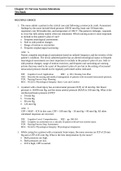
-
Chapter 1 up to 13 Overview of Critical Care Nursing Test BankQuestions & Answers. All 100% Correct.distinction
- Package deal • 12 items • 2022
-
- $30.49
- 1x sold
- + learn more
Patient and Family Response to the Critical Care Patient and Family Response to the Critical Care End-of-Life Care in the Critical Care Unit Comfort and Sedation Nutritional Support Dysrhythmia Interpretation and Management Hemodynamic Monitoring Ventilatory Assistance Rapid Response Teams and Code Management Chapter 13: Nervous Sys

-
Chapter 13: Nervous System Alterations Test Bank
- Exam (elaborations) • 14 pages • 2022
- Available in package deal
-
- $10.49
- + learn more
1. The nurse admits a patient to the critical care unit following a motorcycle crash. Assessment findings by the nurse include blood pressure 100/50 mm Hg, heart rate 58 beats/min, respiratory rate 30 breaths/min, and temperature of 100.5°. The patient is lethargic, responds to voice but falls asleep readily when not stimulated. Which nursing action is most important to include in this patient’s plan of care? a. Frequent neurological assessments b. Side to side position changes c. Rang...

-
Chapter 12: Cardiovascular Alterations Test Bank
- Exam (elaborations) • 13 pages • 2022
- Available in package deal
-
- $9.49
- + learn more
1. The patient is admitted with a suspected acute myocardial infarction (MI). In assessing the 12- lead electrocardiogram (ECG) changes, which findings would indicate to the nurse that the patient is in the process of an evolving Q wave myocardial infarction(MI)? a. ST-segment elevation on ECG and elevated CPK-MB or troponin levels b. Depressed ST-segment on ECG and elevated total CPK c. Depressed ST-segment on ECG and normal cardiac enzymes d. Q wave on ECG with normal enzymes and troponi...
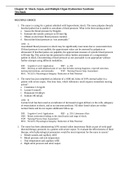
-
Chapter 11: Shock, Sepsis, and Multiple Organ Dysfunction Syndrome Test Bank
- Exam (elaborations) • 15 pages • 2022
- Available in package deal
-
- $9.49
- 2x sold
- + learn more
1. The nurse is caring for a patient admitted with hypovolemic shock. The nurse palpates thready brachial pulses but is unable to auscultate a blood pressure. What is the best nursing action? a. Assess the blood pressure by Doppler. b. Estimate the systolic pressure as 60 mm Hg. c. Obtain an electronic blood pressure monitor. d. Record the blood pressure as “not assessable.” ANS: A Auscultated blood pressures in shock may be significantly inaccurate due to vasoconstriction. If blood ...
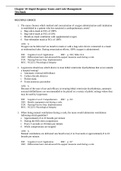
-
Chapter 10: Rapid Response Teams and Code Management Test Bank
- Exam (elaborations) • 11 pages • 2022
- Available in package deal
-
- $9.49
- 1x sold
- + learn more
1. The nurse chooses which method and concentration of oxygen administration until intubation is established in a patient who has sustained a cardiopulmonary arrest? a. Bag-valve-mask at FiO2 of 100% b. Bag-valve-mask at FiO2 of 50% c. Mouth-to-mask ventilation with supplemental oxygen d. Non-rebreather mask at FiO2 of 100% ANS: A Oxygen can be delivered via mouth to mask or with a bag-valve device connected to a mask or endotracheal tube. During resuscitation efforts, 100% oxygen is adm...
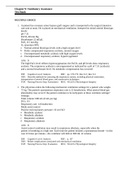
-
Chapter 9: Ventilatory Assistance Test Bank
- Exam (elaborations) • 15 pages • 2022
- Available in package deal
-
- $7.49
- + learn more
1. A patient has coronary artery bypass graft surgery and is transported to the surgical intensive care unit at noon. He is placed on mechanical ventilation. Interpret his initial arterial blood gas levels: pH 7.31 PaCO2 48 mm Hg Bicarbonate 22 mEq/L PaO2 115 mm Hg O2 saturation 99% a. Normal arterial blood gas levels with a high oxygen level b. Partly compensated respiratory acidosis, normal oxygen c. Uncompensated metabolic acidosis with high oxygen levels d. Uncompensated respirato...
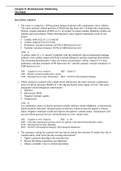
-
Chapter 8: Hemodynamic Monitoring Test Bank
- Exam (elaborations) • 17 pages • 2022
- Available in package deal
-
- $10.99
- 3x sold
- + learn more
1. The nurse is caring for a 100-kg patient being monitored with a pulmonary artery catheter. The nurse assesses a blood pressure of 90/60 mm Hg, heart rate 110 beats/min, respirations 36/min, oxygen saturation of 89% on 3 L of oxygen via nasal cannula. Bilateral crackles are audible upon auscultation. Which hemodynamic value requires immediate action by the nurse? a. Cardiac index (CI) of 1.2 L/min/m3 b. Cardiac output (CO) of 4 L/min c. Pulmonary vascular resistance (PVR) of 80 dynes/se...
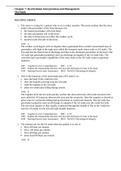
-
Chapter 7: Dysrhythmia Interpretation and Management Test Bank
- Exam (elaborations) • 31 pages • 2022
- Available in package deal
-
- $9.49
- + learn more
1. The nurse is caring for a patient who is on a cardiac monitor. The nurse realizes that the sinus node is the pacemaker of the heart because it is: a. the fastest pacemaker cell in the heart. b. the only pacemaker cell in the heart. c. the only cell that does not affect the cardiac cycle. d. located in the left side of the heart. ANS: A The cardiac cycle begins with an impulse that is generated from a small concentrated area of pacemaker cells high in the right atria called the sinoatr...
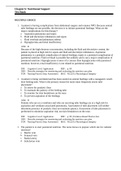
-
Chapter 6: Nutritional Support Test Bank
- Exam (elaborations) • 10 pages • 2022
- Available in package deal
-
- $10.49
- + learn more
1. A patient is having complications from abdominal surgery and remains NPO. Because enteral tube feedings are not possible, the decision is to initiate parenteral feedings. What are the major complications for this therapy? a. Aspiration pneumonia and sepsis b. Fluid and electrolyte imbalances and sepsis c. Fluid overload and pulmonary edema d. Hypoglycemia and renal insufficiency ANS: B Because of the high dextrose concentration, including the fluid and electrolyte content, the patien...
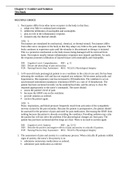
-
Chapter 5: Comfort and Sedation Test Bank
- Exam (elaborations) • 12 pages • 2022
- Available in package deal
-
- $10.49
- + learn more
1. Nociceptors differ from other nerve receptors in the body in that they: a. adapt very little to continual pain response. b. inhibit the infiltration of neutrophils and eosinophils. c. play no role in the inflammatory response. d. transmit only the thermal stimuli. ANS: A Nociceptors are stimulated by mechanical, chemical, or thermal stimuli. Nociceptors differ from other nerve receptors in the body in that they adapt very little to the pain response. The body continues to experience p...

Did you know that on average a seller on Stuvia earns $82 per month selling study resources? Hmm, hint, hint. Discover all about earning on Stuvia


